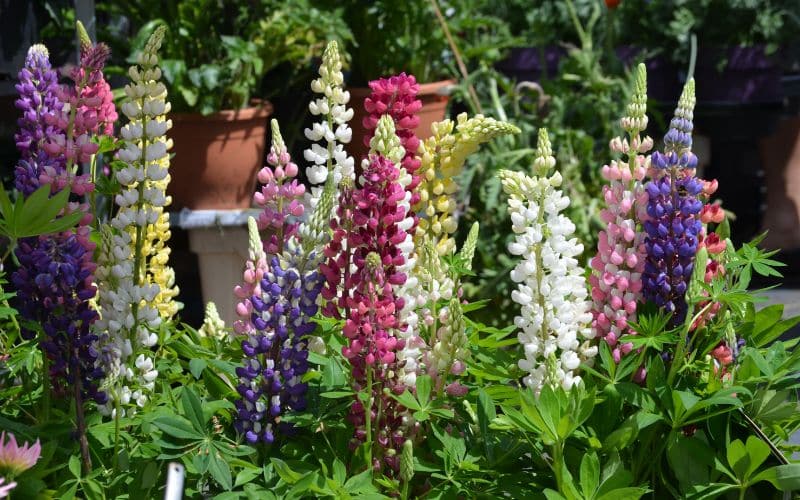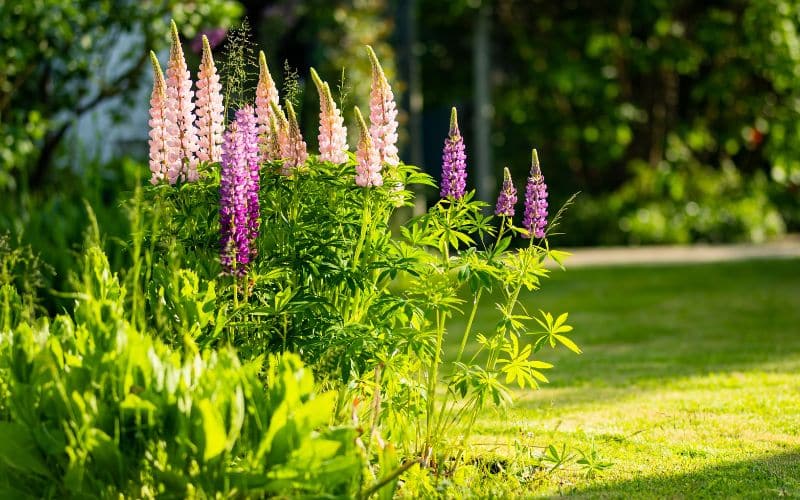
Understanding Lupins: A Quick Overview
We can’t talk about lupins without acknowledging their sheer beauty. These tall, vibrant flowers are a sight to behold in any garden. But there’s more to lupins than just their good looks.
Originating from the Mediterranean region, the Lupinus genus comprises over 200 species. The most common type found in Ontario gardens is the Russell hybrid, known for its spectacular range of colors and hardiness.
The unique thing about lupins is their ability to enrich soil with nitrogen, thanks to symbiotic bacteria living in their root nodules. This means they’re not just pretty – they’re practical too!
At maturity, lupin plants reach heights of up to 1.5 meters (4-5 feet) and flower from late spring into summer.
Here’s a quick snapshot of typical lupin characteristics:
| Trait | Detail |
|---|---|
| Height | Up to 1.5 meters (4-5 feet) |
| Bloom time | Late spring – Summer |
| Soil preference | Well-drained |
Lupins aren’t picky when it comes to sunlight; they’ll thrive in full sun or partial shade – as long as they’re well-watered! That said, keep an eye out for slugs and snails that love munching on young lupin leaves.
To sum it up:
- Lupins are versatile, growing comfortably under various light conditions.
- They’re beneficial for soil health due to nitrogen-fixing abilities.
- Watch out for pests like slugs and snails!
Now that we’ve set the stage with this overview of lupins, let’s dive deeper into how you can successfully grow these stunning blooms right here in Ontario!
The Ideal Soil for Growing Lupins in Ontario
Cultivating lupins in Ontario’s diverse climate can be quite rewarding. It’s essential to recognize that these vibrant flowers have a preference when it comes to soil composition. Let me share some knowledge on the ideal soil conditions for growing lupins successfully in this region.
Lupins favor well-drained, slightly acidic soils. A pH level of 5.5 to 6.5 is typically best. While they’re hardy plants and can adapt to various conditions, waterlogged or overly alkaline soils could lead to their demise.
If you’re unsure about your garden soil’s acidity level, don’t fret! You can easily test your garden soil using a home testing kit available at most gardening stores.
There are several ways to adjust your soil if it doesn’t meet the pH criteria; adding organic matter like compost or well-rotted manure often helps improve drainage and lower alkalinity.
- Compost
- Well-rotted manure
Indeed, lupins aren’t just picky about pH levels but also prefer sandy or loamy soils over clay-based ones due to better drainage capabilities.
Remember that while preparing your garden for planting lupins, deep digging is beneficial as these flowers have long tap roots that delve deep into the ground seeking nutrients.
In my experience, understanding and providing the right soil condition plays a pivotal role in nurturing healthy and vibrant lupin plants.
So take time out for this initial preparation – it sets the stage for a beautiful display of these stunning blooms down the line!
Remember: An ideal start leads to hearty growth!

Selecting the Perfect Spot in Your Garden
Choosing the right location for your lupins is crucial. It’s not just about where you’d like them to grow, but also about giving them the best possible conditions for thriving. Lupins are sun lovers and they need at least six hours of sunlight each day.
Full Sunlight is Key
Select an area that receives full sunlight for most of the day. However, a bit of afternoon shade can be beneficial, especially during Ontario’s hot summers.
While lupins are adaptable and can tolerate partial shade, too much shadow could stifle their growth and lead to fewer blooms.
Well-drained Soil is Essential
Lupins prefer well-drained soil – it’s a non-negotiable condition for these plants. They dislike waterlogged areas which may lead to root rot – a common cause of death in lupin plants.
If you’re dealing with clay or compacted soil, you may need to improve its structure before planting lupins. This can be achieved by adding organic matter such as compost or well-rotted manure.
Consider the Space
Remember that mature lupin plants need space. Plant your seeds or seedlings at least 12-16 inches apart from each other to allow room for growth.
Here’s a quick checklist:
- Full sunlight (at least 6 hours)
- Well-drained soil
- Sufficient spacing between plants (12-16 inches)
Planting and Caring for Lupins
I’ve found that lupins aren’t too fussy when it comes to their growing conditions. They’re pretty hardy plants that can thrive in a wide range of environments. But, if you want your lupins to truly flourish here in Ontario, there are a few key steps I recommend following.
First off, let’s talk about soil. Lupins prefer well-drained soil with a neutral or slightly acidic pH level. You’ll find they don’t do so well in heavy clay or water-logged areas. If your garden tends towards these conditions, I’d suggest adding some organic matter like compost or well-rotted manure to improve drainage.
Next up is light exposure. While lupins can handle partial shade, they really love full sun – we’re talking at least 6 hours of direct sunlight each day.
When it comes to planting, early spring is the best time to get your lupin seeds in the ground here in Ontario. Soak the seeds overnight before planting them about 1/4 inch deep into the soil.
Now onto one of my favorite topics: watering! Regular watering is crucial during the growing season, but you don’t want to overdo it either as too much water can lead to root rot.
Lastly, let’s touch on pests and diseases – no plant is immune unfortunately! Aphids and slugs are common pests for lupins while powdery mildew and crown rot are possible diseases they might face. Keep an eye out for signs of these issues and take action quickly if spotted!
Tackling Common Pests and Diseases of Lupins
When you’re growing lupins in Ontario, it’s crucial to stay vigilant about potential pests and diseases. This is because these flowers can be susceptible to a variety of issues that could hinder their growth or even cause them to die off completely.
One common pest that attacks lupins is the aphid. These tiny insects feed on the sap of plants, causing them to become weak and stunted. If you notice your lupins looking less than healthy, it’s worth checking under the leaves for these small bugs. You’ll usually find them in clusters.
Other pests include:
- Slugs and snails: They love munching on young lupin shoots, so watch out for telltale slime trails.
- Cucumber beetles: These critters are attracted by the sweet scent of lupin flowers.
To tackle pests, I recommend using organic methods first such as introducing beneficial insects like ladybugs who eat aphids or using beer traps for slugs and snails.
Next up are diseases – one major threat is powdery mildew. This fungal disease creates a white powdery coating on leaves which eventually turn brown and die off. It thrives in humid conditions but is easily treated with a fungicide spray.
Another disease affecting lupins is root rot caused by overly wet soil conditions. To avoid this ensure good drainage when planting your lupins.
Lastly, beware of Lupin anthracnose, a fungus that causes dark spots on stems and leaves accompanied by twisted growth.
Here’s a quick rundown:
| Pests/Diseases | Symptoms | Solution |
|---|---|---|
| Aphids | Weakness/stunting | Introduce beneficial insects |
| Slugs/snails | Eaten shoots/slime trails | Beer traps |
| Cucumber Beetles | Damage to flowers/leaves | Organic repellants |
| Powdery Mildew | White powder/brown leaves | Fungicide spray |
| Root Rot | Wilted yellow leaves/poor growth | Improve drainage |
| Lupin Anthracnose | Dark spots/twisted growth | Fungicides |
Remember, prevention is always better than cure! Regularly inspect your plants for signs of damage and take swift action if necessary.

Harvesting and Enjoying Your Lupin Blooms
The joy of growing lupins in Ontario doesn’t stop at planting and nurturing them. It’s when the blooms burst into color that the true reward unfolds. I’ve found this to be a truly mesmerizing moment, one that makes all your gardening efforts worth it.
Harvesting lupins is as simple as it’s enjoyable. Typically, you’ll want to cut the flower stalks once about half of the individual buds have opened on each stalk. But remember, don’t wait too long! If we let all flowers open fully before harvesting, they may begin to lose their vitality.
Here are some steps I follow when harvesting my lupin blooms:
- Use sharp scissors or pruners.
- Cut the stem at an angle for better water absorption later.
- Place them directly into a bucket of lukewarm water after cutting.
Now comes my favorite part: enjoying these beautiful flowers! Lupins make amazing additions to any bouquet with their vibrant colors and unique shape. The tall spires add height, interest, and contrast in floral arrangements.
I’ve also found that lupins can last up to a week in a vase if cared for properly. Here are a few tips to extend their beauty:
- Change the water every two days.
- Keep them out of direct sunlight.
- Recut stems under water every few days.
Growing lupins in Ontario has been one of my greatest pleasures as a gardener. Not only do these hardy perennials thrive here, but they also bring such joy with their striking blooms – from harvesting time right through till they grace our homes or tables in stunning arrangements!
In conclusion, whether you’re an experienced green thumb or just starting your gardening journey – take it from me: growing and enjoying your own harvested lupin blooms is definitely worth giving it a shot!
Colin Macmillan is a seasoned entrepreneur and the CEO of Riverwood Landscape, a leading landscaping company based in Canada. He has been at the helm of the company since leaving high school, demonstrating his strong leadership skills and business acumen.
Colin’s expertise lies in various aspects of landscaping, including lawn care, interlocking, sod installation, and commercial maintenance. His hands-on approach and dedication to the craft have been instrumental in building Riverwood Landscape into a reputable brand.
One of his most notable achievements is the creation of a successful landscape franchise that services multiple locations. This accomplishment underscores his strategic thinking and ability to scale operations effectively.
Colin has also had the privilege of working with Guelph Hospital for landscaping and maintenance, a testament to the trust and reliability that his company has earned over the years.
His professional mission is to offer the best services and experiences for customers, a goal that he tirelessly pursues. Colin’s commitment to excellence and customer satisfaction continues to drive the growth and success of Riverwood Landscape.








